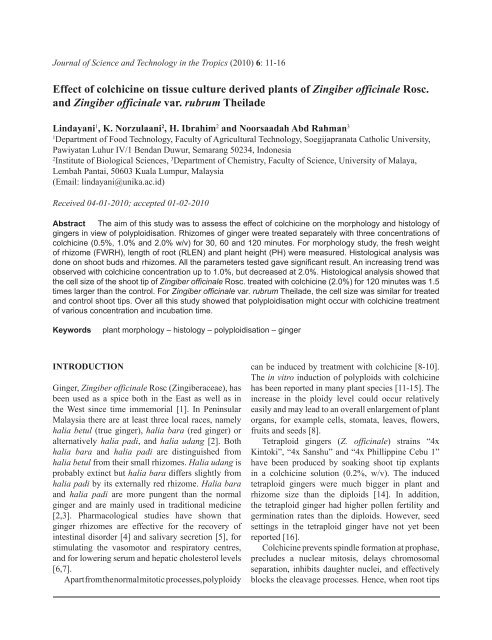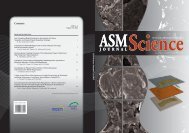Download - Akademi Sains Malaysia
Download - Akademi Sains Malaysia
Download - Akademi Sains Malaysia
Create successful ePaper yourself
Turn your PDF publications into a flip-book with our unique Google optimized e-Paper software.
Journal of Science and Technology in the Tropics (2010) 6: 11-16<br />
Effect of colchicine on tissue culture derived plants of Zingiber officinale Rosc.<br />
and Zingiber officinale var. rubrum Theilade<br />
Lindayani 1 , K. Norzulaani 2 , H. Ibrahim 2 and Noorsaadah Abd Rahman 3<br />
1 Department of Food Technology, Faculty of Agricultural Technology, Soegijapranata Catholic University,<br />
Pawiyatan Luhur IV/1 Bendan Duwur, Semarang 50234, Indonesia<br />
2 Institute of Biological Sciences, 3 Department of Chemistry, Faculty of Science, University of Malaya,<br />
Lembah Pantai, 50603 Kuala Lumpur, <strong>Malaysia</strong><br />
(Email: lindayani@unika.ac.id)<br />
Received 04-01-2010; accepted 01-02-2010<br />
Abstract The aim of this study was to assess the effect of colchicine on the morphology and histology of<br />
gingers in view of polyploidisation. Rhizomes of ginger were treated separately with three concentrations of<br />
colchicine (0.5%, 1.0% and 2.0% w/v) for 30, 60 and 120 minutes. For morphology study, the fresh weight<br />
of rhizome (FWRH), length of root (RLEN) and plant height (PH) were measured. Histological analysis was<br />
done on shoot buds and rhizomes. All the parameters tested gave significant result. An increasing trend was<br />
observed with colchicine concentration up to 1.0%, but decreased at 2.0%. Histological analysis showed that<br />
the cell size of the shoot tip of Zingiber officinale Rosc. treated with colchicine (2.0%) for 120 minutes was 1.5<br />
times larger than the control. For Zingiber officinale var. rubrum Theilade, the cell size was similar for treated<br />
and control shoot tips. Over all this study showed that polyploidisation might occur with colchicine treatment<br />
of various concentration and incubation time.<br />
Keywords plant morphology – histology – polyploidisation – ginger<br />
INTRODUCTION<br />
Ginger, Zingiber officinale Rosc (Zingiberaceae), has<br />
been used as a spice both in the East as well as in<br />
the West since time immemorial [1]. In Peninsular<br />
<strong>Malaysia</strong> there are at least three local races, namely<br />
halia betul (true ginger), halia bara (red ginger) or<br />
alternatively halia padi, and halia udang [2]. Both<br />
halia bara and halia padi are distinguished from<br />
halia betul from their small rhizomes. Halia udang is<br />
probably extinct but halia bara differs slightly from<br />
halia padi by its externally red rhizome. Halia bara<br />
and halia padi are more pungent than the normal<br />
ginger and are mainly used in traditional medicine<br />
[2,3]. Pharmacological studies have shown that<br />
ginger rhizomes are effective for the recovery of<br />
intestinal disorder [4] and salivary secretion [5], for<br />
stimulating the vasomotor and respiratory centres,<br />
and for lowering serum and hepatic cholesterol levels<br />
[6,7].<br />
Apart from the normal mitotic processes, polyploidy<br />
can be induced by treatment with colchicine [8-10].<br />
The in vitro induction of polyploids with colchicine<br />
has been reported in many plant species [11-15]. The<br />
increase in the ploidy level could occur relatively<br />
easily and may lead to an overall enlargement of plant<br />
organs, for example cells, stomata, leaves, flowers,<br />
fruits and seeds [8].<br />
Tetraploid gingers (Z. officinale) strains “4x<br />
Kintoki”, “4x Sanshu” and “4x Phillippine Cebu 1”<br />
have been produced by soaking shoot tip explants<br />
in a colchicine solution (0.2%, w/v). The induced<br />
tetraploid gingers were much bigger in plant and<br />
rhizome size than the diploids [14]. In addition,<br />
the tetraploid ginger had higher pollen fertility and<br />
germination rates than the diploids. However, seed<br />
settings in the tetraploid ginger have not yet been<br />
reported [16].<br />
Colchicine prevents spindle formation at prophase,<br />
precludes a nuclear mitosis, delays chromosomal<br />
separation, inhibits daughter nuclei, and effectively<br />
blocks the cleavage processes. Hence, when root tips<br />
Jostt vol 6.indd 11 7/22/10 10:08:33 PM<br />
11

















